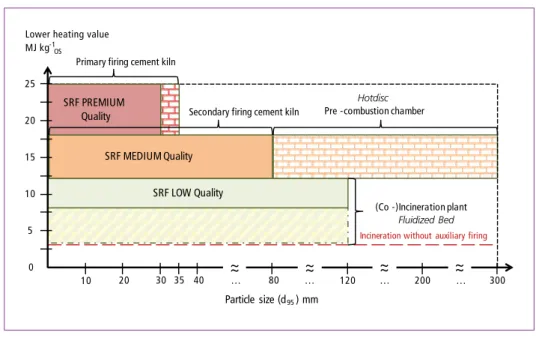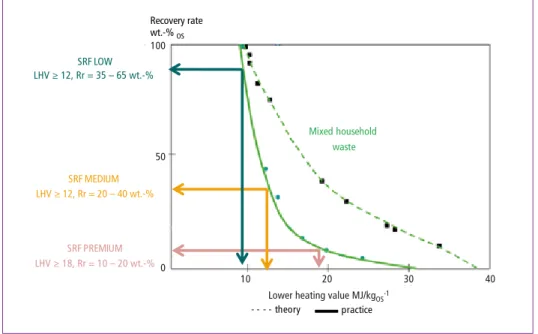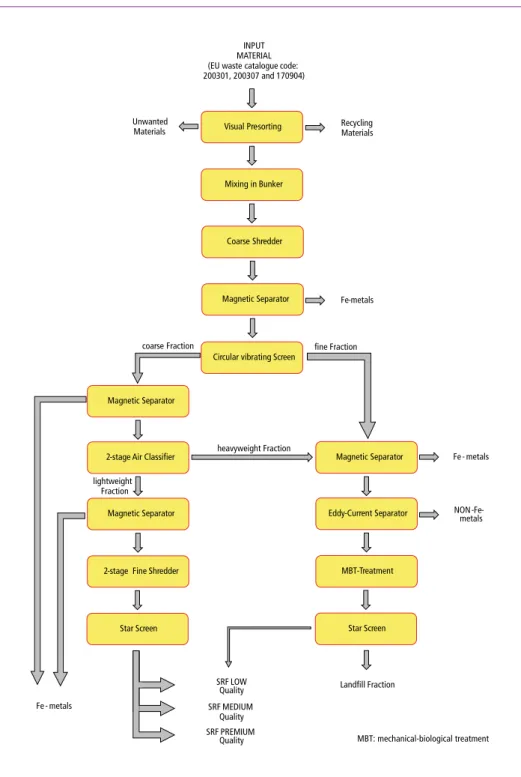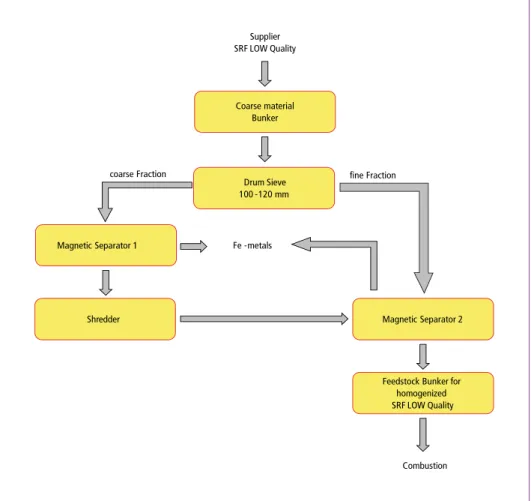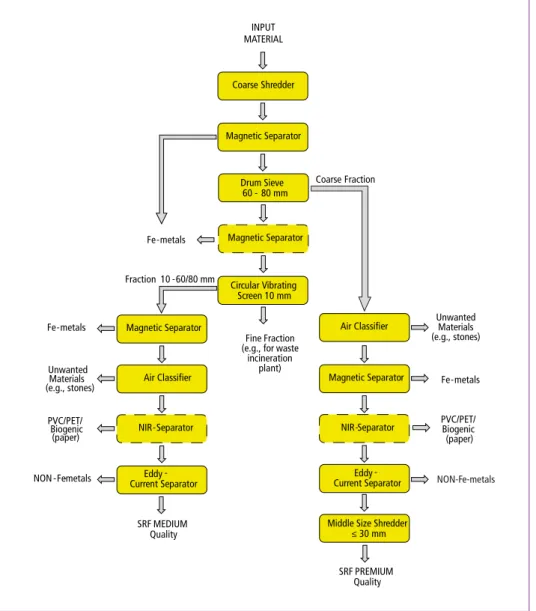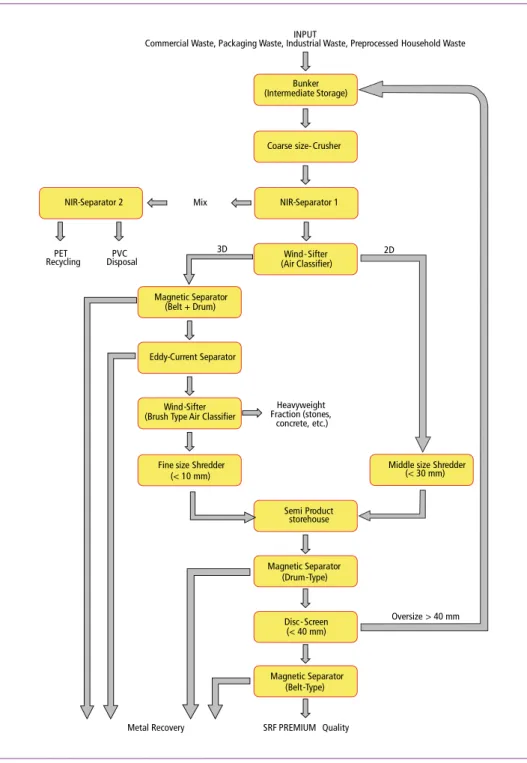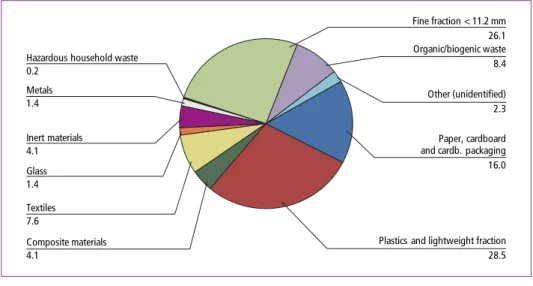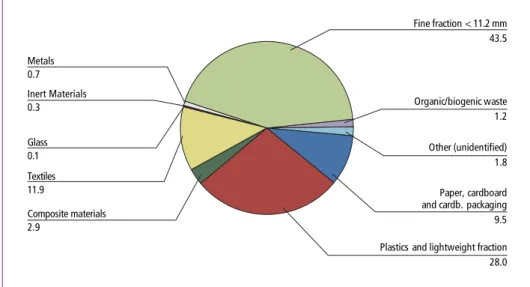MBT and SRF
Manufacturing of Solid Recovered Fuels (SRF) for Energy Recovery Processes
Renato Sarc, Karl E. Lorber and Roland Pomberger
1. Case study: Manufacturing of three types of SRF ...406
1.1. Manufacturing of SRF low quality for fluidized bed incinerator plant ...406
1.1.1. External production of SRF low quality ...406
1.1.2. Internal confectioning and homogenisation of SRF low quality from various suppliers ...408
1.2. Manufacturing of SRF medium quality and SRF premium quality for cement kiln ...409
2. Results: Quality of investigated SRF ...411
2.1. Results from manual sorting analyses ...412
2.2. Results from physical-chemical analyses ...413
3. Conclusions ...414
4. References ...415 This contribution describes manufacturing processes and quality of three types of Solid Recovered Fuels – i.e. SRF low quality, SRF medium quality and SRF premium quality – that are used in energy recovery plants. In total, two case studies are reported.
First case study is about the external processing and confectioning of non-hazardous household, industrial and commercial mixed wastes as well as the internal treatment and homogenisation of various waste fractions at the incineration plant for production of SRF low quality that is utilized in a Waste to Energy (WtE) stationary Fluidized Bed Incinerator. In the second case study, production of SRF medium quality and SRF pre- mium quality that are used for substitution of primary fuels like coal and petrol coke in the cement kiln is described. Finally, data on SRF quality of all three investigated waste types will be summarized and discussed.
Definitions: RDF, SRF and energy recovery The European Directive on waste (2008/98/EC) sets definitions and issues the basic concept for development of sustainable waste management in the EU. In the directive, the definition of recycling and recovery is given as follow [6]:
• recycling means any recovery operation by which waste materials are reprocessed into products, materials or substances whether for the original or other purposes. It includes the reprocessing of organic material but does not include energy recovery and the reprocessing into materials that are to be used as fuels or for backfilling operations,
MBT and SRF
• recovery means any operation the principal result of which is waste serving a useful purpose by replacing other materials which would otherwise have been used to fulfil a particular function, or waste being prepared to fulfil that function, in the plant or in the wider economy. Annex II sets out a non-exhaustive list of recovery operations.
In order to attain the energy recovery status and not the disposal status, the R1 formula has to be considered. R1 criteria – use principally as a fuel or other means to generate energy, [6] – for energy efficiency determines, that municipal solid waste incineration plants must have an efficiency equal to or above:
• 0.60 for installation in operation and permitted in accordance with applicable Com- munity legislation before January 1, 2009 and
• 0.65 for installation permitted after December 31, 2008 using the defined formula [6].
Recovery of thermal energy from municipal solid waste (like: mixed household waste, bulky waste etc.) usually is accomplished by mono-incineration plants (e.g. grate-firing systems and fluidized bed systems) or in co-incineration units (e.g. utility boilers, power plants or cement kilns), where pre-treated waste is used as alternative feedstock for substitution of fossil fuel.
In Austria, the definition of Refuse-Derived Fuels (RDF) is given in the legally binding Waste Incineration Ordinance [2] as:
…waste that is used entirely or to a relevant extent for the purpose of energy generation and which satisfies the quality criteria laid down in this directive…
Therefore, after adequate and extensive (pre-)treatment in different processing plants and applying strictly defined quality assurance measures, various non-hazardous and/
or hazardous waste materials from households, commerce, and industry can be used as RDF in co-incineration plants, like: sewage sludge, waste wood, high-calorific frac- tions from mechanical-physical (MP) or mechanical-biological (MB) treatment plants, calorific fractions of household and commercial wastes, shredder light fractions (e.g.
from old vehicles and waste electric and electronic equipment), scrap tyres, waste oil, used solvents and animal fat and bone meal etc. [10].
In the narrow sense of the definition, Solid Recovered Fuels (SRF) refers only to solid waste fuels which are prepared from non-hazardous, sorted or mixed solid wastes.
Therefore, SRF is a subgroup of RDF which is also subject to legally defined quality assurance measures and limit values and means, as defined in CEN [3].
Requirements for manufacturing of SRF from mixed non-hazardous wastes
As already mentioned, SRF is a mixture of various non-hazardous waste materials from different sources (e.g. households, commerce and industry), that are undergoing distinct treatment and manufacturing steps like: multistage shredding, classifying, separation of Fe- and NON-Fe-metals, exclusion of heavyweight inert materials, as well as sorting out of unwanted materials like polyvinyl chloride (PVC) or of recycling materials like PET, Figure 3, Figure 5 and Figure 6.
MBT and SRF
The input waste materials that are treated in SRF processing plants can be described by their European waste code and description in accordance with the European List of Waste [5] (Table 1).
Table 1: Input waste materials for SRF
04_02_09 wastes from composite materials (impregnated textile, elastomer, plastomer) 07_02_13 waste plastic
15_01_01 paper and cardboard packaging 15_01_02 plastic packaging
15_01_06 mixed packaging
17_09_04 mixed construction and demolition wastes other than those mentioned in 17_09_01, 17_09_02 and 17_09_03
19_12_12 other wastes (including mixtures of materials) from mechanical treatment of wastes other than those mentioned in 19_12_11
20_01_01 paper and cardboard 20_01_39 plastics
20_03_01 mixed municipal waste (household waste) 20_03_01 mixed municipal waste (commercial wastes) 20_03_07 bulky waste
The output/produced SRF is legally not considered as a product but still is waste, clas- sified by two waste codes:
• 19_12_10: (quality assured) combustible waste (i.e. SRF) and
• 19_12_12: other wastes from mechanical treatment of wastes – i.e. RDF.
Additionally, plant-technical aspects have to be considered, when using SRF in different mono- or co-incineration plants. Technical properties concerned may be divided into a few groups, e.g., chemical (i.e. separation between combustible/non-combustible substances, volatile matter content etc.), mechanical (density of combustible/non- combustible substances, bulk properties etc.), calorific (i.e. heating value, adiabatic combustion temperature etc.) and reaction technical properties (i.e. ignition tempe- rature, combustion behaviour, slag formation, corrosion potential etc.). [1]
Next to the legal requirements regarding the quality of SRF before its energy recovery – i.e. limit values for eight heavy metals according to the Austrian Waste Incineration Ordinance [2], – additional fuel specifications like:
• lower calorific value (LHV): [MJ kgOS-1],
• particle size (d95) [mm],
• water content [%OS],
• ash content [%DM or %OS],
• chlorine content [%DM] as well as
• bulk density [kg mOS-3]
MBT and SRF
may be defined and requested by different SRF-(co-)Incineration plants, for being fixed in the contract between suppliers and users.
In Figure 1, quality of SRF, expressed as correlation between SRF particle size (d95 [mm]) and lower heating value [MJ kgOS-1], with regard to the energy recovery options is depicted. As shown, for autonomous, self-supporting incineration without addition of external fuel, theoretically a net calorific value Hu ≥ 3 [MJ kgOS-1] is necessary for fluidized bed incinerators. For grate-firing systems, the net calorific value should be:
Hu ≥ 5 [MJ kgOS-1]. Therefore, the conditions for autonomous combustion of waste are met with [8]:
• combustible matter: > 25 %,
• ash content: < 65 %,
• water content: < 50 %.
Within the EU, this is no problem, as the LHV for mixed household waste after separate collection is between 9.5 and 11.5 [MJ kgOS-1] [8].
5 10 15 20 25
10 20 30
MJ kg-1OS
Particle size (d95) mm
… 80
40 … 120 … 200 … 300
0
SRF LOW Quality
Incineration without auxiliary firing SRF MEDIUM Quality
SRF PREMIUM Quality
35 Primary firing cement kiln
Secondary firing cement kiln
Hotdisc Pre -combustion chamber
(Co -)Incineration plant Fluidized Bed
~~ ~~ ~~ ~~
Lower heating value
Figure 1: Relation between SRF particle size and lower heating value with regard to the energy recovery options
Source: Sarc, R.: Herstellung, Qualität und Qualitätssicherung von Ersatzbrennstoffen zur Erreichung der 100%-igen thermischen Substitution in der Zementindustrie (Design, Quality and Quality Assurance of Solid Recovered Fuels (SRF) for Achieving 100%
Thermal Substitution in Cement Industry). PhD-Work (Doctoral Thesis) at Montanuniversitaet Leoben, Austria, 2015
In total, the following three here investigated SRF types are used in (Co-)Incineration plants:
• SRF low quality: having d95 ≤ 120 [mm] and 3 ≤ LHV ≤ 12 [MJ kgOS-1] and is used for energy recovery in WtE stationary fluidized bed incinerator,
MBT and SRF
• SRF medium quality: having d95 ≤ 80 (for Hotdisc: d95 ≤ 300) [mm] and 12 ≤ LHV
≤ 18 [MJ kgOS-1] and is used for energy recovery in secondary firing systems of cement kiln and/or in special pre-combustion chambers like Hotdisc – further in- formation about Hotdisc is presented in Sarc et al. [15],
• SRF premium quality: having d95 ≤ 30 (up to 35) [mm] and 18 ≤ LHV ≤ 25 [MJ kgOS-1] and is used for energy recovery in primary firing system of cement kiln.
As shown in next Figure 2, the recovery rate of a certain defined SRF quality – low, medium and/or premium – will depend on the input waste quality and the multistage SRF-production process applied. In some cases, this may lead to a conflict of interests between quantity (amount of SRF recovered from a certain type of input waste) and quality required by customer. Additionally, separate treatment of different waste material streams is necessary for processing of different SRF qualities and specifications. In this connection, the discrimination between 2-dimensional (2D) and 3-dimensional (3D) grains (pieces) is also advisable – extensively discussed in Lorber and Sarc [9], – because cubic grains show different combustion behaviour compared to plane particles, i.e. foils and flat matters alike. In any case, a multistage process with repeated unit operation steps – i.e. several times crushing, sieving and separating – is necessary for obtaining the required quality and uniformity of SRF, due to the inherent complexity of the input material waste (Table 1). As mentioned before, the final quality of SRF will ultimately depend on the composition of the input (feeding) materials, as well as on the extent and the intensity of the applied recovery process [13].
- - - - theory practice Mixed household
waste Recovery rate
wt.-%OS
Lower heating value MJ/kgOS-1 100
50
0 10 20 30 40
SRF PREMIUM SRF MEDIUM SRF LOW
LHV ≥ 12, Rr = 20 – 40 wt.-%
LHV ≥ 18, Rr = 10 – 20 wt.-%
LHV ≥ 12, Rr = 35 – 65 wt.-%
Figure 2: Correlation between lower heating value and recovery rate for mixed household waste
Source: Sarc, R.: Herstellung, Qualität und Qualitätssicherung von Ersatzbrennstoffen zur Erreichung der 100%-igen thermischen Substitution in der Zementindustrie (Design, Quality and Quality Assurance of Solid Recovered Fuels (SRF) for Achieving 100%
Thermal Substitution in Cement Industry). PhD-Work (Doctoral Thesis) at Montanuniversitaet Leoben, Austria, 2015
MBT and SRF
Figure 2 represents the practical relationship – i.e. results of a SRF recovery plant, – whereas the dotted line reflects the theory – i.e. results of manual sorting analysis. It becomes clear, that one cannot expect a high recovery rate and a high quality at the same time. For premium quality of high calorific SRF (i.e. LHV ≥ 18 MJ kgOS-1) used in primary firing system of cement kilns, the recovery rate is about 10 to 20 wt.-% for mixed municipal waste input [12]. Also, it does not make sense to mix two different types of input materials before starting the recovery process in the SRF processing plant, as the separating conditions become more complex, resulting in lower quality and/or lower recovery rates of the required product.
Also the results on collection and treatment of different waste types – i.e. household waste and commercial waste, – presented in the study Krigez [7], confirm these fin- dings. Separate collection of dried – i.e. higher heating value– commercial waste and its treatment in specialised processing plants is recommended.
1. Case study: Manufacturing of three types of SRF
First of all, it has to be noted, that selected concepts for processing SRF from different waste sources for (Co-)Incineration plants were already presented in Waste Manage- ment – published by Thomé-Kozmiensky and Thiel – by Deditz et al. [4], Pomberger and Sarc [11], Sarc et al. [14]. Here, additional data and information on manufacturing of SRF in Austria is given.
1.1. Manufacturing of SRF low quality for fluidized bed incinerator plant
A comprehensive study was carried out on the characterization of waste fuels burnt in a fluidized bed incinerator plant during approximately 2 years – from 2011 to 2013 [13].
Here, the input materials: Household Waste (EU waste code 20_03_01-mixed muni- cipal waste), Commercial Wastes (EU waste code 20_03_01-mixed municipal waste), Bulky Waste (EU waste code 20_03_07) and Construction Site Waste (EU waste code 17_09_04-mixed construction and demolition wastes other than those mentioned in 17_09_01, 17_09_02 and 17_09_03) [5] are undergoing external (i.e. by the different suppliers) and internal (i.e. at the incineration plant) treatment to produce SRF low quality. [13]
1.1.1. External production of SRF low quality
As shown in Figure 3, a multistage mechanical processing plant is used by the different suppliers for the external production of SRF – i.e. low quality, medium quality and premium quality.
Summarized, it means that a modern and advanced mechanical waste processing concept consists of at least two or even three shredding steps, at least two magnetic separation steps (rejection of Fe-metals), at least one eddy-current separator (rejecting of NON-Fe-metals, mostly only applied for fine fraction) and, depending on customer requirements, at least two sieving steps. Different types of multistage mechanical sorting plants operating in Austria are depicted in detail in UBA [16, 17].
MBT and SRF
Figure 3: External mechanical waste processing plant for production of, among others, SRF low quality
Source: Sarc, R.; Lorber, K.E.: Production, quality and quality assurance of Refuse Derived Fuels (RDFs). In: Waste Management 33, 2013; ISSN: 0956-053X
Visual Pre-sorting
Mixing in Bunker
Circular vibrating Screen
Magnetic Separator
2-stage Air Classifier
Magnetic Separator
2-stage Fine Shredder
coarse Fraction fine Fraction
INPUT MATERIAL (EU waste catalogue code:
200301, 200307 and 170904)
Fe - metals SRF MEDIUM
Quality Coarse Shredder Unwanted
Materials Recycling
Materials
Magnetic Separator Fe-metals
Star Screen
SRF LOW Quality
SRF PREMIUM Quality lightweight
Fraction
Magnetic Separator heavyweight Fraction
Eddy-Current Separator
Fe - metals
NON-Fe- metals
Landfill Fraction MBT-Treatment
Star Screen
MBT: mechanical-biological treatment
MBT and SRF
1.1.2. Internal confectioning and homogenisation of SRF low quality from various suppliers
The externally – in various mechanical plants – produced SRF low quality is delivered to the fluidized bed incinerator plant (mostly) by walking floor trucks – about 21 to 25 t weight and 90 m3 volume – which empty their load into the coarse material bunker, Figure 4. As already shown in Chapter 1.1.1., different types of waste processing plants are used for external waste fuel preparation. To increase the incinerator feedstock qua- lity – by homogenizing parameters like: lower heating value, particle size (d95), water and ash content, – an additional internal (simple) waste processing unit is required. By using this so-called in-unit with shredding process, the particle size of oversized, coarse particles (d95 > 100 to 120 [mm]) is automatically reduced, which results, among others, in improved fuel-technical characteristics. To remove the residual metals efficiently from SRF low quality, it is important to apply one more magnetic separation step. [13]
Drum Sieve 100 -120 mm
Magnetic Separator 1
Shredder
coarse Fraction fine Fraction
Supplier SRF LOW Quality
Coarse material Bunker
Magnetic Separator 2
Feedstock Bunker for homogenized SRF LOW Quality Fe -metals
Combustion
Figure 4: Internal in-unit for confectioning and homogenisation of SRF low quality
Source: Sarc, R.; Lorber, K.E.: Production, quality and quality assurance of Refuse Derived Fuels (RDFs). In: Waste Management 33, 2013; ISSN: 0956-053X
MBT and SRF
As shown in Figure 4, after sieving, separation of Fe-metals (2 x) and shredding of oversized particles, the SRF low quality with defined particle size is ready for energy recovery and it is stored in the incinerator feedstock bunker.
1.2. Manufacturing of SRF medium quality and SRF premium quality for cement kiln
Figure 5: Multistage processing scheme of one of the investigated plants for the combined production of different SRF qualities; dotted line indicates that a NIR separator may be skipped or installed in a multiple design
Source: Sarc, R.; Lorber, K.E.; Pomberger, R.; Rogetzer, M.; Sipple, E.M.:Design, Quality and Quality Assurance of Solid Re- covered Fuels (SRF) for the Substitution of Fossil Feedstock in the Cement Industry. In: Waste Management & Research 32 (7), 2014; DOI: 10.1177/0734242X14536462
Coarse Shredder
Magnetic Separator
Circular Vibrating Screen 10 mm Magnetic Separator
Air Classifier
NIR-Separator
Eddy - Current Separator Fraction 10 -60/80 mm
Middle Size Shredder ≤ 30 mm Coarse Fraction INPUT
MATERIAL
Drum Sieve 60 - 80 mm
Magnetic Separator
Magnetic Separator
Eddy - Current Separator Fe-metals
SRF PREMIUM Quality Fine Fraction
(e.g., for waste incineration
plant) Fe-metals
Air Classifier Unwanted Materials (e.g., stones)
NIR-Separator PVC/PET/
Biogenic (paper) Unwanted
Materials
(e.g., stones) Fe-metals
PVC/PET/
Biogenic (paper)
NON -Fe-metals
SRF MEDIUM Quality
NON-Fe-metals
MBT and SRF
Figure 6: Multistage processing scheme of 100,000 t y-1 ThermoTeam plant for manufacturing of SRF premium quality
Source: Sarc, R.; Lorber, K.E.; Pomberger, R.: Production of Solid Recovered Fuels (SRF) in the ThermoTeam Plant in Retznei, Austria – Experience, Quality and Quality Assurance of SRF. In: Thomé-Kozmiensky, K.J.; Thiel, S. (eds.): Waste Management, Volume 5. Neuruppin: TK Verlag Karl Thomé-Kozmiensky, 2015, pp. 399-412; ISBN: 978-3-944310-22-0
Bunker (Intermediate Storage)
Coarse size-Crusher
Wind-Sifter (Air Classifier)
Magnetic Separator (Belt + Drum)
Eddy-Current Separator
Wind-Sifter (Brush Type Air Classifier
Fine size Shredder (< 10 mm)
Semi Product storehouse
Magnetic Separator (Drum-Type)
Disc-Screen (< 40 mm)
Magnetic Separator (Belt-Type) 3D
Middle size Shredder (< 30 mm) 2D
Oversize > 40 mm INPUT
Commercial Waste, Packaging Waste, Industrial Waste, Preprocessed Household Waste
Mix
Metal Recovery SRF PREMIUM Quality
NIR-Separator 1
Heavyweight Fraction (stones,
concrete, etc.) NIR-Separator 2
RecyclingPET PVC Disposal
MBT and SRF
Austrian mechanical-biological treatment (MBT) plants and other waste processing plants like splitting plants etc. for primary mechanical treatment of non-hazardous mixed household and similar industrial waste are the producers of various SRF quali- ties. If the required multistage processing technology is available at one site, SRF with higher quality – i.e. higher heating value and narrow defined particle size (d95) ≤ 103D – 302D [mm]; note: for 2-dimensional (2D) and 3-dimensional (3D) grains separately – like SRF premium quality can be produced. If not, a combination of different SRF types with various rather modest specifications and quality classes is possible. Figure 5 presents a multistage processing scheme of an investigated plant for the combined production of SRF medium quality (i.e. coarse material) and SRF premium quality (i.e. fine material) [8]. As mentioned before, when preparing high quality SRF with strictly defined specifications, a multistage process including distinct shredding steps with different particle sizes (d95 = 60 to 100 mm and 20 to 40 mm) respectively, magnetic separation (removal of Fe-metals), eddy-current separation (removal of NON-Fe-metals) and sieving steps is required.
If a waste treatment plant does not have the proper technology for final manufacturing of SRF – i.e. final waste processing including fine comminution, – medium quality SRF (coarse waste fuels) only can be produced on site. These pre-treated coarse materials may undergo final treatment in downstream specialized multistage plants for the production of premium quality SRF, like the one that is processed in the 100,000 t a-1 ThermoTeam- SRF-plant (Figure 6) which is described in detail in Lorber and Sarc [9] and Sarc et al. [14].
When manufacturing high quality SRF, there are some unwanted elements like chlorine (Cl), antimony (Sb), mercury (Hg) and chromium (Cr) in the waste stream, the con- centration of which have to be controlled in the end product. For example, chlorine is mainly introduced by PVC in plastic waste and salt (NaCl) from foodstuff – residues in lightweight packaging waste fractions. Antimony is present as stabilizer in plastics, e.g.
in polyethylene terephthalate (PET) drinking water bottles [14, 15].
2. Results: Quality of investigated SRF
In following Figure 7, all three investigated types of SRF (Figure 1) are depicted. At a first glance, it becomes obvious that the particle size of the SRF types presented is completely different.
Figure 7: SRF low quality (left), SRF medium quality (centre) and SRF premium quality (right)
Source: Sarc, R.: Herstellung, Qualität und Qualitätssicherung von Ersatzbrennstoffen zur Erreichung der 100%-igen thermischen Substitution in der Zementindustrie (Design, Quality and Quality Assurance of Solid Recovered Fuels (SRF) for Achieving 100%
Thermal Substitution in Cement Industry). PhD-Work (Doctoral Thesis) at Montanuniversitaet Leoben, Austria, 2015
MBT and SRF
2.1. Results from manual sorting analyses
For characterization, in Figure 8, Figure 9 and Figure 10, summarized results from manual sorting analyses of all the three investigated SRF types are presented. In Figure 8, results for SRF low quality are expressed as mean value of results from manual sorting analyses of three different supplier materials from two different pro- cessing plants – i.e. plant 1-material 1, plant 1-material 2 and plant 2-material 1 [13].
Paper, cardboard and cardb. packaging 6.8 Plastics and lightweight fraction 20.8 Composite materials
3.0 Textiles 5.1 Glass 1.0 Inert materials 6.8 Metals 2.6
Hazardous household waste 0.2
Fine fraction < 16 mm 42.6 Organic/biogenic waste 9.6
Other (unidentified) 1.6
Paper, cardboard and cardb. packaging 16.0
Plastics and lightweight fraction 28.5 Composite materials
4.1 Textiles 7.6 Glass 1.4 Inert materials 4.1 Metals 1.4
Hazardous household waste 0.2
Fine fraction < 11.2 mm 26.1 Organic/biogenic waste 8.4 Other (unidentified) 2.3
Figure 8: Results (mean values) from manual sorting analyses of SRF low quality
Source: Sarc, R.: Herstellung, Qualität und Qualitätssicherung von Ersatzbrennstoffen zur Erreichung der 100%-igen thermischen Substitution in der Zementindustrie (Design, Quality and Quality Assurance of Solid Recovered Fuels (SRF) for Achieving 100%
Thermal Substitution in Cement Industry). PhD-Work (Doctoral Thesis) at Montanuniversitaet Leoben, Austria, 2015
Figure 9: Results (mean values) from manual sorting analyses of SRF medium quality
Source: Sarc, R.: Herstellung, Qualität und Qualitätssicherung von Ersatzbrennstoffen zur Erreichung der 100%-igen thermischen Substitution in der Zementindustrie (Design, Quality and Quality Assurance of Solid Recovered Fuels (SRF) for Achieving 100%
Thermal Substitution in Cement Industry). PhD-Work (Doctoral Thesis) at Montanuniversitaet Leoben, Austria, 2015
MBT and SRF
In Figure 9, average results for SRF medium quality derived from seven different plants (B1-B7) are shown [15]. And in Figure 10, results – i.e. mean value – for SRF premium quality from five different plants (A1-A5) are presented [15].
Paper, cardboard and cardb. packaging 9.5 Plastics and lightweight fraction 28.0 Composite materials
2.9 Textiles 11.9 Glass 0.1 Inert Materials 0.3 Metals 0.7
Fine fraction < 11.2 mm 43.5
Organic/biogenic waste 1.2 Other (unidentified) 1.8
Figure 10: Results (mean values) from manual sorting analyses of SRF premium
Source: Sarc, R.: Herstellung, Qualität und Qualitätssicherung von Ersatzbrennstoffen zur Erreichung der 100%-igen thermischen Substitution in der Zementindustrie (Design, Quality and Quality Assurance of Solid Recovered Fuels (SRF) for Achieving 100%
Thermal Substitution in Cement Industry). PhD-Work (Doctoral Thesis) at Montanuniversitaet Leoben, Austria, 2015
From presented results of the manual sorting analyses it becomes evident, that as ex- pected, the higher the quality of SRF (e.g. premium), the higher is the amount of high calorific fractions – i.e. paper, cardboard and cardboard packaging, plastics and light- weight fraction, composite materials and textiles – and the lower is the amount of (inert) impurities – i.e. glass, inert materials, metals and hazardous household waste, Table 2.
Table 2: Summarized results from manual sorting analyses of all three investigated SRF types Fractions SRF low quality SRF medium quality SRF premium quality
w%OS w%OS w%OS
PPCT (paper, plastics, composites and textiles) 35.6 56.2 52.4 INERT (glass, inerts, metals, hazardous waste) 10.6 7.1 1.1 Fine fraction and organic (fine fraction,
organic and biogenic and unidentified) 53.8 36.7 46.5
2.2. Results from physical-chemical analyses
As reported in Table 3, selected results of a comprehensive study on quality assurance of SRF are summarized [12, 13, 14, 15].
MBT and SRF As shown in Table 3, the more is the quality of SRF type (i.e. low vs medium vs premi- um), the higher is the value of energy relevant parameter (i.e. LHV) and the lower are both mass balance relevant parameters (i.e. moisture and ash content). Comparing SRF medium quality and SRF premium quality regarding LHV [MJ kgOS-1] and their PPCT content (Table 2 – 56.2 vs. 52.4 [wt.-%OS]), it becomes obvious that the increased amount of fraction paper, cardboard and cardboard packaging (Figure 9 – 16.0 [wt.-%] vs. Figure 10 – 9.5 [wt.-%]) in SRF medium quality is one of the main water-content-suppliers in SRF also. Another interesting aspect is that with higher quality of SRF type, the amounts and ratio of procedural relevant parameters like chlorine and sulphur content become higher too. Finally, the more is the quality of SRF type, the more are fossil CO2-emission, due to the higher content fossil components in fractions like textile and fine fraction
< 11.2 mm, that will be generated by energy recovery. In summary, it becomes evident that the ultimate goal of energy recovery from SRF, i.e. to save primary material and energy resources and to reduce emissions, may result in so-called conflict of interests.
3. Conclusions
When talking about subjects like Waste as a Resource or Energy Management, it becomes clear that energy recovery from SRF manufactured out of mixed waste in (co-)Incineration plants is having an important role in circular economy and sustain- able waste management.
To manufacture a SRF, different non-hazardous wastes from household, commerce and industry, bulky waste as well as various (residuals from) packaging wastes etc. are pro- cessed in modern mechanical processing plants. The higher the SRF quality should be – Table 3: Selected results from physical-chemical analyses of all three investigated SRF types
Parameter unit SRF low quality SRF medium quality SRF premium quality
Med. 80th Med. 80th Med. 80th
Moisture content %OS 26.5 31.4 25.0 29.1 15.1 29.3 Lower heating value OS MJ kgOS-1 8.9 10.3 15.5 16.8 19.3 22.8 Lower heating value DM MJ kgDM-1 14.3 15.7 21.2 21.4 25.0 26.6 Ash content w%OS 29.6 35.2 12.7 15.8 12.4 14.8 Chlorine content g kgDM-1 9.2 12.3 10.8 22.2 13.8 17.1 Sulphur content g kgDM-1 2.9 3.7 3.4 4.6 3.3 4.5 Ratio chlorine/sulphur - 3.2 3.3 3.2 4.8 4.2 3.8 Total carbon content w%DM - - 46.9 48.6 52.8 58.3 Fossil CO2 emiss. factor g MJDM-1 - - 34.5 41.3 43.2 55.7
note: Med. = Median; 80th = 80th percentile Sources:
Sarc, R.; Lorber, K.E.: Production, quality and quality assurance of Refuse Derived Fuels (RDFs). In: Waste Management 33, 2013; ISSN: 0956-053X
Sarc, R.; Lorber, K.E.; Pomberger, R.; Rogetzer, M.; Sipple, E.M.:Design, Quality and Quality Assurance of Solid Recovered Fuels (SRF) for the Substitution of Fossil Feedstock in the Cement Industry. In: Waste Management & Research 32 (7), 2014; DOI:
10.1177/0734242X14536462
MBT and SRF
i.e. higher LHV but lower particle size (d95) and impurity content, – the greater is the extent of the waste pre-treatment and processing steps needed. The quality of SRF manufactured depends primarily on the input waste materials as well as on type and extent of processing steps applied in the multistage (mechanical/physical) SRF proces- sing plants. Additionally, when innovative sorting techniques like NIR-separation are integrated in the SRF-manufacturing process, different plastic fractions (like for energy recovery processes unwanted PVC or for recycling processes valuable PET that may contribute to circular economy) can be detected and separated out of process stream.
In the case studies reported, obtained results on the quality of three different SRF types manufactured, namely SRF low quality, SRF medium quality and SRF premium quality, are presented.
The described results for all three types of SRF are representing qualities that are available on the Austrian waste fuel market for utilization in energy recovery processes.
Selected fuel parameters – i.e. LHV as well as chlorine and sulphur content and/or fossil CO2-emission factor – that describe the quality of SRF produced however reflect a conflict of interests. In most cases, an increase of LHV is directly related to a parallel increase of chlorine content and fossil CO2-emission factor in SRF. Nevertheless, the successful application of SRF for energy recovery in the (Austrian) (co-)Incineration plants has become State of the Art.
4. References
[1] Beckmann, M.; Pohl, M.; Bernhardt, D.; Gebauer, K.: Criteria for solid recovered fuels as a sub- stitute for fossil fuels – a review. In: Waste Management & Research 30 (4), 2012, pp. 354-369;
DOI: 10.1177/0734242X12441237
[2] BMLFUW: Verordnung des Bundesministers für Land- und Forstwirtschaft, Umwelt und Was- serwirtschaft und des Bundesministers für Wirtschaft, Familie und Jugend über die Verbrennung von Abfällen (Abfallverbrennungsverordnung – AVV) [Waste Incineration Ordinance (WIO)].
2002, StF: BGBl. II Nr. 389/2002
[3] CEN: CENprEN 15359:2011 Solid recovered fuels – Specifications and classes. Brussels, Belgium:
CEN, 2011
[4] Deditz, J.; Pinkel, M.; Pomberger, R.: Concepts for Processing Solid Recovered Fuels of Different Waste Origins for Waste-to-Energy Plants. In: Thomé-Kozmiensky, K.J.; Thiel, S. (eds.): Waste Management, Volume 4. Neuruppin: TK Verlag Karl Thomé-Kozmiensky, 2014, pp. 455-470;
ISBN: 978-3-944310-15-2
[5] Environmental Protection Agency: European waste catalogue and hazardous waste list. Ireland:
EPA, 2002
[6] EU (European Union): Directive 2008/98/EC of the European Parliament and of the Council of 19. November 2008 on waste and repealing certain Directives. Brussels, Belgium, 2008 [7] FA 19D (Amt der Steiermärkischen Landesregierung, Fachabteilung 19D): Kriterien zur Tren-
nung von Siedlungsabfall aus Industrie und Gewerbe als Voraussetzung zur Zuordnung zu Behandlungsverfahren (KRIGEZ) [Criteria for separation of municipal waste from industry and commerce as requirement for allocation of waste to the treatment process]. Österreich, 2008 [8] Lorber, K.E.; Sarc, R.: Recovery of Heat, Power and Secondary Materials by Incineration of
Mixed Municipal Solid Waste (MSW). In: Proceedings of the 5th international conference on Environmental Technology and Knowledge Transfer (eds. Nelles, M. et al.). Hefei, P.R. China, May 15-16, 2014; ISBN: 978-3-86009-411-2
MBT and SRF
[9] Lorber, K.E.; Sarc, R.: Waste to Energy by Preparation of Quality Controlled Solid Recovered Fuels (SRF). In: Proceedings of the 4th international conference on Environmental Technology and Knowledge Transfer (eds. Nelles, M. et al.). Hefei, P.R. China, May 24-25, 2012; ISBN: 978- 3-86009-125-8
[10] Lorber, K.E.; Sarc, R.; Aldrian, A.: Design and quality assurance for solid recovered fuel. In:
Waste Management & Research 30 (4), 2012; DOI: 10.1177/0734242X12440484
[11] Pomberger, R.; Sarc, R.: Use of Solid Recovered Fuels in the Cement Industry. In: Thomé-Kozmiensky, K.J.; Thiel, S. (eds.): Waste Management, Volume 4. Neuruppin: TK Verlag Karl Thomé-Kozmi- ensky, 2014, pp. 471-487; ISBN: 978-3-944310-15-2
[12] Sarc, R.: Herstellung, Qualität und Qualitätssicherung von Ersatzbrennstoffen zur Erreichung der 100%-igen thermischen Substitution in der Zementindustrie (Design, Quality and Quality Assurance of Solid Recovered Fuels (SRF) for Achieving 100% Thermal Substitution in Cement Industry). PhD-Work (Doctoral Thesis) at Montanuniversitaet Leoben, Austria, 2015
[13] Sarc, R.; Lorber, K.E.: Production, quality and quality assurance of Refuse Derived Fuels (RDFs).
In: Waste Management 33, 2013; ISSN: 0956-053X
[14] Sarc, R.; Lorber, K.E.; Pomberger, R.: Production of Solid Recovered Fuels (SRF) in the Ther- moTeam Plant in Retznei, Austria – Experience, Quality and Quality Assurance of SRF. In:
Thomé-Kozmiensky, K.J.; Thiel, S. (eds.): Waste Management, Volume 5. Neuruppin: TK Verlag Karl Thomé-Kozmiensky, 2015, pp. 399-412; ISBN: 978-3-944310-22-0
[15] Sarc, R.; Lorber, K.E.; Pomberger, R.; Rogetzer, M.; Sipple, E.M.:Design, Quality and Quality Assurance of Solid Recovered Fuels (SRF) for the Substitution of Fossil Feedstock in the Cement Industry. In: Waste Management & Research 32 (7), 2014; DOI: 10.1177/0734242X14536462 [16] UBA (Umweltbundesamt) (ed.): Ist-Stand der Mechanisch-Biologischen Abfallbehandlung
(MBA) in Österreich – Zustandsbericht 2006 (Status quo of mechanical biological treatment (MBT) in Austria – State Report 2006). Vienna, Austria, 2006
[17] UBA (Umweltbundesamt) (ed.): Mechanische Abfallbehandlung (MA) von gemischten Sied- lungs- und Gewerbeabfällen in Österreich (Mechanical Waste Treatment (MT) of mixed Household and Commercial Waste in Austria). Vienna, Austria, 2008
Bibliografische Information der Deutschen Nationalbibliothek Die Deutsche Nationalbibliothek verzeichnet diese Publikation in der Deutschen Nationalbibliografie; detaillierte bibliografische Daten sind im Internet über http://dnb.dnb.de abrufbar
Thomé-Kozmiensky, K. J.; Thiel, S. (Eds.): Waste Management, Volume 6 – Waste-to-Energy –
ISBN 978-3-944310-29-9 TK Verlag Karl Thomé-Kozmiensky
Copyright: Professor Dr.-Ing. habil. Dr. h. c. Karl J. Thomé-Kozmiensky All rights reserved
Publisher: TK Verlag Karl Thomé-Kozmiensky • Neuruppin 2016
Editorial office: Professor Dr.-Ing. habil. Dr. h. c. Karl J. Thomé-Kozmiensky,
Dr.-Ing. Stephanie Thiel, M. Sc. Elisabeth Thomé-Kozmiensky, Janin Burbott-Seidel und Claudia Naumann-Deppe
Layout: Sandra Peters, Anne Kuhlo, Janin Burbott-Seidel, Claudia Naumann-Deppe, Ginette Teske, Gabi Spiegel und Cordula Müller
Printing: Universal Medien GmbH, Munich
This work is protected by copyright. The rights founded by this, particularly those of translation, reprinting, lecturing, extraction of illustrations and tables, broadcasting, micro- filming or reproduction by other means and storing in a retrieval system, remain reserved, even for exploitation only of excerpts. Reproduction of this work or of part of this work, also in individual cases, is only permissible within the limits of the legal provisions of the copyright law of the Federal Republic of Germany from 9 September 1965 in the currently valid revision. There is a fundamental duty to pay for this. Infringements are subject to the penal provisions of the copyright law.
The repeating of commonly used names, trade names, goods descriptions etc. in this work does not permit, even without specific mention, the assumption that such names are to be considered free under the terms of the law concerning goods descriptions and trade mark protection and can thus be used by anyone.
Should reference be made in this work, directly or indirectly, to laws, regulations or guide- lines, e.g. DIN, VDI, VDE, VGB, or these are quoted from, then the publisher cannot ac- cept any guarantee for correctness, completeness or currency. It is recommended to refer to the complete regulations or guidelines in their currently valid versions if required for ones own work.

